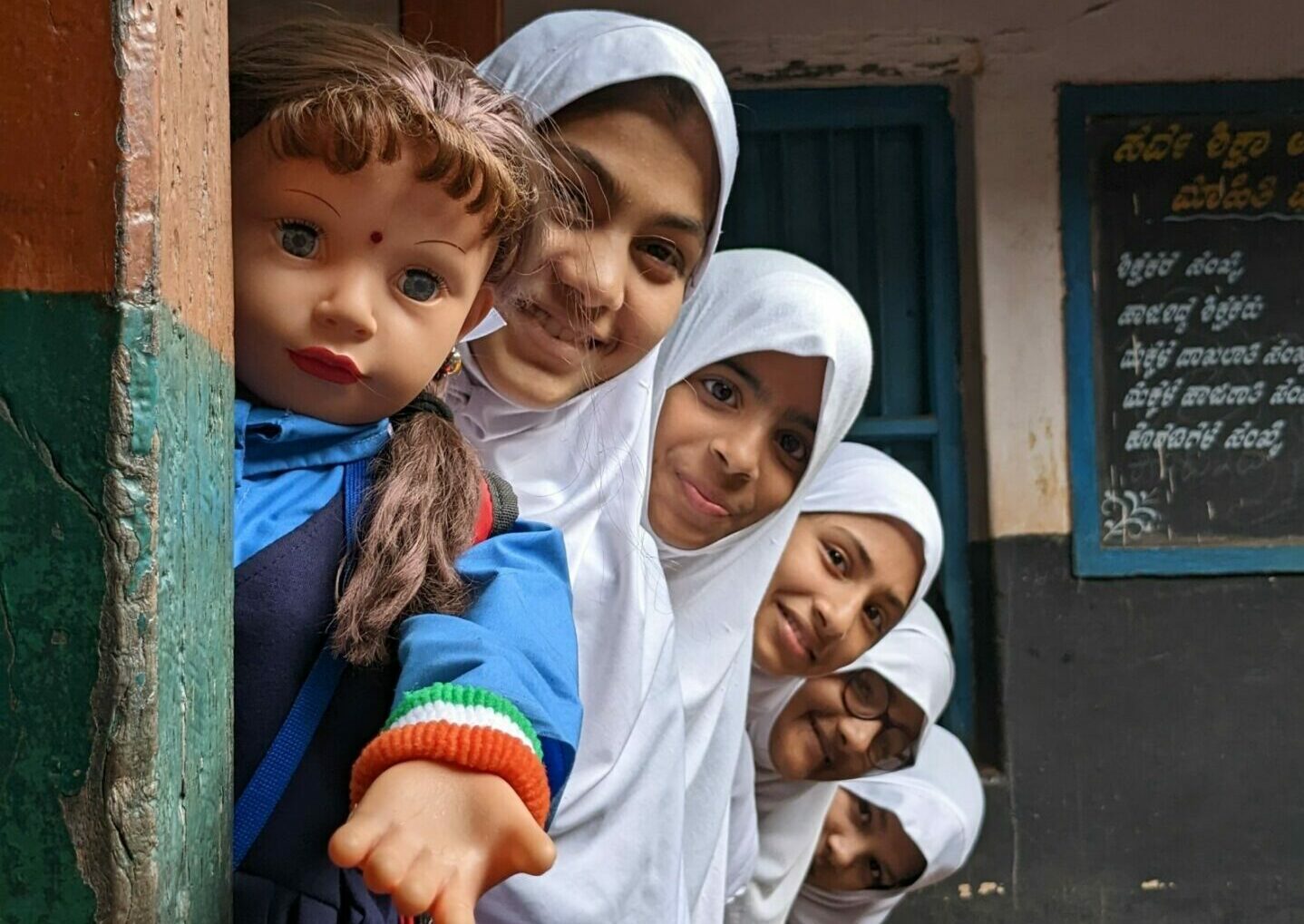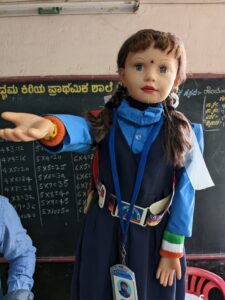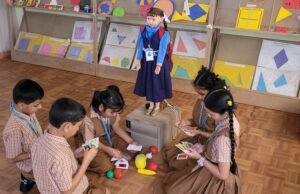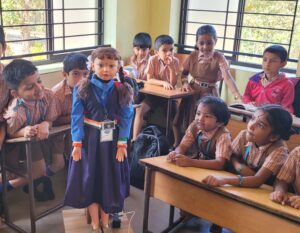Created by physics professor Akshay Mashelkar, the humanoid is a hit among teachers and students.

Shiksha, a humanoid created by Prof Akshay Mashelkar has been a hit among rural students of pre-primary and primary schools in Sirsi, Karnataka. (Supplied)
In the rural regions of Karnataka, India, where access to education and technology is limited, a new kind of teacher has emerged — Shiksha the robot.
This is a robot designed to teach Karnataka primary school children in an innovative and interactive way.

Shiksha, a humanoid created by Akshay Mashelkar, a professor from Sirsi, Karnataka. (Supplied)
Wearing a light and dark blue uniform, her hair in two braids, an ID card around her neck, an Indian flag-coloured belt, and a school bag, the robot looks just like one of the girls from the rural government schools of Sirsi district in Karnataka.
“Post-Covid, when children returned to school, I noticed a massive gap not just in learning, but also human values amongst children. I felt teachers needed to re-look at not just the gaps in education and learning, but also re-instill human values in them. I thought Shiksha can help in filling the learning gaps and teachers could utilise that time in teaching values,” says proud creator of the humanoid, Prof Akshay Mashelkar.
Akshay Mashelkar, a native of Sirsi, is a physics postgraduate with an electronics specialisation — and he has a BEd degree too. He currently works as a lecturer in Chaitanya MES PU College in Sirsi.
Mashelkar, who was more interested in generating creative teaching pedagogies, writing scripts for plays, puppet shows, and so on, decided to invest his time and money in starting his own research centre that would cater to his interests.
In a small space inside the make-up room of a ‘Ranga Mandira’, he started the Vikram Sarabhai Educational Research Centre.
“We are mainly researching on art and technology integration in education. There is a receiving end (children) and a transmitting end (teachers) in any given educational set-up. But I have noticed that the method of transmitting education has remained constant and very few changes have been done to improve that,” Mashelkar told South First.
A team of students, scholars from various fields, teachers, researchers living across India are part of his curriculum team and he consults with them before forming a curriculum to set in his humanoid.
Mashelkar states that now there is only the chalk-and-blackboard method and the online method of teaching. “So this space needs some changes and integration of art and technology can create wonders,” he says.
With this intention, during the pandemic, his research team began work on Shiksha, a humanoid robot that can transmit knowledge very differently to rural children in Karnataka.
Shiksha, which looks very human-like, can don the hat of a teacher and teach a variety of subjects, including Kannada rhymes, English rhymes, names of the days of the week, identification of shapes, months in a year, the English alphabet, and even multiplication tables.

Students learning about shapes, vegetables and fruits in a rural primary school in Sirsi from Shiksha. (Supplied)
Shiksha is an educational tool that children can learn new things from while playing and interacting with it, says Mashelkar.
Mashelkar explains, “For now, she is programmed to teach up to Class 4. Handling her is extremely easy as I understand the difficulties of teachers in rural schools to use technology,” explains Mashelkar.
Shiksha, being called “a friend from the future”, can make any boring class interesting, adds a proud Mashelkar.
He says that the humanoid is also built creatively and in an interactive manner. “The teaching method here is a hands-on, active learning experience. It emphasises learning through doing. Skills they learn are put out in real-life scenarios. Math is taught to them using vegetables and fruits that they see in their daily lives. Addition, subtraction, multiplication concepts are taught with real-life examples,” he explains.
Mashelkar says that Shiksha the robot can teach names of fruits and vegetables too. “When the child places a card with a picture of a pineapple in it, Shiksha will not only read out the name of the fruit but also say the spelling and inform during which months it can be commonly grown, etc. There are many such interactive lessons it can do. There are ‘repeat after me’ sessions too. These help to teach tables, names of the days, poems, rhymes, etc,” he adds.
Interestingly, Shiksha is being used by Mashelkar to teach his pre-university (PU) students as well. Here, they are being taught how to build a humanoid like Shiksha.
The PU students are all taking a liking to this and are even inspired to come up with their own robots doing various other tasks, Mashelkar says.
Shiksha, which was born in early 2022, has visited more than 25 schools and has become a hit among rural pre-primary and primary school children in Karnataka.
“The introduction of Shiksha into the classroom has been a huge success, both among students and teachers. With her charming appearance and interactive teaching style, she has captured the attention of even the most disinterested students, making learning more enjoyable and effective,” says the professor.
He says that as soon as he enters a school premises carrying Shiksha, the students start crowding around her. That one hour they get to spend with Shiksha is always not enough for them.
Some girls even set her hair right, make sure her ribbons are tied properly; boys tend to shake hands with her, look at her in awe, Mashelkar tells us!
“They feel she is one of them. It’s like they have found a new friend. They never disrespect her or behave mischievously with her,” he adds.
He says that one of the main advantages of using Shiksha in the classroom is that she can personalise her teaching to meet the individual needs of each student.
“This is particularly beneficial in rural areas where class sizes can be large and teachers may struggle to provide individualised attention to every student,” he says.
The creator of this humanoid robot that has become a hit among rural primary school children in Karnataka is now looking to take his invention to the next level. The professor has expressed his desire to approach the Education Department of the state to incorporate the robot as a part of the curriculum.
He says, “Shiksha has been liked not only by students, but even by teachers and headmasters of all the schools we have visited in the last one year. If Shiksha becomes part of the schools, then the teachers can rest assured that the children’s learning skills and attention span will increase.”
Shiksha’s ability to teach in multiple languages, including Kannada and English, has made her a valuable asset in schools where language barriers can often be a major obstacle to learning. With her help, students can learn and practice different languages in a fun and engaging way, says Mashelkar.

Engrossed students listening to ‘Shiksha’ the humanoid created by a physics professor in Sirsi, Karnataka. (supplied)
Also, the use of technology in the classroom has been shown to improve student engagement and motivation.
Shiksha’s ability to interact with students in a fun and engaging way has not only made learning more enjoyable, but has also helped students to retain the information better.
Mashelkar expects Education Minister BC Nagesh to provide an opportunity to meet him with Shiksha to brief on the project and his plans about various other things Shiksha could do if the department inculcates it into the curriculum and appoints ‘Shiksha’ as one of the teachers!
He says even other government schools can adopt Shiksha and help in continuation of developing the curriculum that can be installed in her.
“She can definitely teach higher grades too. I can make her eyes move, add video projection capabilities, do much more with the robot. I only need some funds and opportunities,” Mashelkar says.
Hailing from a middle class family from a village in Sirsi, Mashelkar has been doing all these with his own funds.
He says, “There is much more that Shiksha can do and I have all the ability and skills to make her an even more powerful educational tool, but I lack funds.”
Now, his research centre will also have to move from its current location as the cultural centre has been built there and they are ready to operate.
With her charming appearance, the ability to teach in multiple languages, and low-cost nature, Shiksha can become a valuable asset to the education system and a symbol of hope for the future of education in rural India, reiterates Mashelkar.
“It can revolutionise the way children are taught and make learning more accessible, enjoyable and effective. By incorporating the robot into the curriculum, students would have access to an innovative and interactive way of learning that could help to improve their academic performance and overall educational experience. Do join hands with me and adopt Shiksha,” Mashelkar appeals.

Jul 27, 2024

Jul 26, 2024

Jul 26, 2024

Jul 26, 2024

Jul 26, 2024

Jul 26, 2024